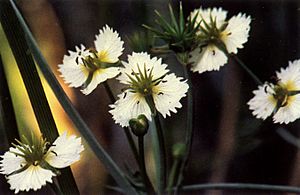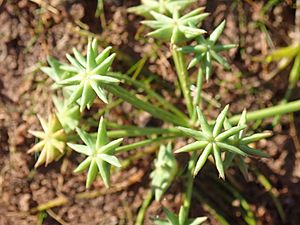Starfruit facts for kids
Quick facts for kids Starfruit |
|
|---|---|
 |
|
| Damasonium californicum | |
 |
|
| Damasonium minus (fruit) | |
| Scientific classification |
|
| Kingdom: | Plantae |
| Clade: | Tracheophytes |
| Clade: | Angiosperms |
| Clade: | Monocots |
| Order: | Alismatales |
| Family: | Alismataceae |
| Genus: | Damasonium Mill. |
| Species | |
|
See text |
|
Damasonium is a group of six different types of flowering plants. They are often called starfruit because their fruits look a bit like stars. Another older name for them is thrumwort. These plants belong to a plant family called Alismataceae. You can find Damasonium plants in many parts of the world, but they grow in specific, scattered places.
These plants are water plants that live for many years (they are perennial). They are also herbaceous plants, meaning they have soft stems, not woody ones like trees. They usually grow in shallow water or in the mud next to ponds.
Their leaves all grow from the base of the plant. Some leaves float on the water, while others stand up in the air if the plant is growing on the edge of a pond.
The flowers of Damasonium plants have both male and female parts (they are hermaphrodite). They grow in groups called whorls, which are like rings of flowers around the stem. These whorls can form different shapes, like umbels (where flower stalks come from one point), racemes (flowers on short stalks along a main stem), or panicles (a branched group of flowers).
Each flower has six stamens (the male parts that make pollen) and six to nine carpels (the female parts that contain seeds). These carpels are joined at the bottom and form a ring. Each carpel has many ovules, which are like tiny eggs that can become seeds. The styles are at the top of the carpels.
After the flowers bloom, they produce fruit. The fruit is a group of follicles, which are dry fruits that split open when ripe. These follicles are flat on the sides and spread out like a star. They also have a pointy tip.
Discovering Starfruit Plants
The group of plants known as Damasonium was first officially described by a person named Philip Miller in 1754. He was a famous botanist, someone who studies plants.
Types of Starfruit Plants
As of May 2014, scientists recognize six different types, or species, of Damasonium plants. Here are some of them and where they grow:
- Damasonium alisma - You can find this plant in places like Great Britain, France, Spain, Italy, Greece, Russia, and Kazakhstan.
- Damasonium bourgaei - This species grows around the Mediterranean Basin and in India.
- Damasonium californicum - This type of starfruit plant lives in the western United States, including states like California, Oregon, and Washington.
- Damasonium constrictum - This plant is found in Kazakhstan and the Altay region of Siberia.
- Damasonium minus - This species grows in Australia.
- Damasonium polyspermum - You can find this plant in Spain, France, Portugal, Greece, Sicily, Algeria, Libya, and Morocco.
See also
 In Spanish: Carambola para niños
In Spanish: Carambola para niños

